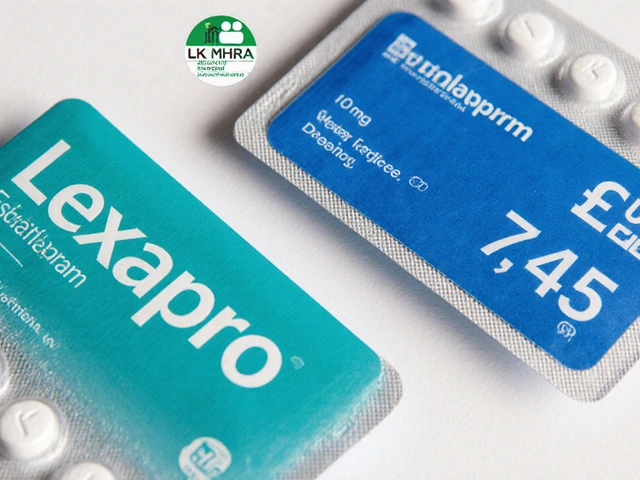Aromasin is not a drug you take for a cold or a headache. It’s a powerful medicine used in the fight against certain types of breast cancer. If you’ve been prescribed Aromasin, or you’re researching it for someone who has, you’re probably looking for clear, honest answers - not medical jargon or fluff. Here’s what you actually need to know.
What Aromasin Is and How It Works
Aromasin is the brand name for the drug exemestane. It belongs to a class of medicines called aromatase inhibitors. These drugs work by blocking the enzyme aromatase, which turns androgens (male hormones) into estrogen in the body. In postmenopausal women, most estrogen comes from this process - not from the ovaries, which have stopped working.
Some breast cancers feed on estrogen. If your cancer is estrogen receptor-positive (ER+), cutting off estrogen can slow or stop the cancer’s growth. That’s where Aromasin steps in. It doesn’t remove estrogen from your body - it stops your body from making more of it.
Unlike tamoxifen, which blocks estrogen from binding to cancer cells, Aromasin cuts off the supply at the source. That’s why it’s often used after tamoxifen, or as a first-line treatment in women who can’t take tamoxifen.
Who Takes Aromasin and Why
Aromasin is approved for postmenopausal women only. That’s because premenopausal women still produce estrogen from their ovaries, and Aromasin can’t block that source effectively. For younger women, other treatments like ovarian suppression are combined with aromatase inhibitors - but Aromasin alone won’t work.
There are three main reasons a doctor might prescribe Aromasin:
- Early-stage breast cancer after surgery: To reduce the chance of cancer coming back. Many women take it for 5 to 10 years after surgery and/or radiation.
- Switching from tamoxifen: After 2-3 years on tamoxifen, some women switch to Aromasin for the remaining 2-5 years of hormone therapy. Studies show this reduces recurrence risk more than staying on tamoxifen the whole time.
- Advanced breast cancer: For cancer that has spread beyond the breast, Aromasin can help control growth when other hormone therapies have stopped working.
It’s not used in men, and it’s not used for prevention in healthy women - only for those already diagnosed with ER+ breast cancer.
How You Take Aromasin
Aromasin comes as a 25 mg tablet. You take one pill by mouth every day, at the same time, with or without food. It doesn’t matter if you eat first - just be consistent.
You won’t feel it working. There’s no immediate change in how you feel. That’s normal. The goal isn’t to make you feel better right away - it’s to prevent cancer from returning years down the line.
Most people take it for five years. Some take it for up to ten, depending on their risk level and how well they tolerate side effects. Stopping early because of side effects can increase the chance of cancer coming back. Talk to your doctor before making any changes.
Common Side Effects
Because Aromasin lowers estrogen, it triggers symptoms similar to menopause - but often more intense. These aren’t rare. Most women on Aromasin experience at least a few.
- Joint and muscle pain: This is the most common complaint. Some women describe it as a deep ache in the hips, knees, or fingers. It’s not arthritis - it’s hormone withdrawal. Moving helps, and some find relief with low-dose painkillers or physical therapy.
- Hot flashes: Night sweats, sudden warmth, flushing. These can be mild or disruptive. Dress in layers, keep the bedroom cool, and avoid triggers like caffeine and alcohol.
- Fatigue: Not just tiredness - a heavy, dragging exhaustion. It’s not laziness. It’s your body adjusting to low estrogen.
- Bone thinning: Estrogen protects bone density. With less of it, your bones can weaken over time. Doctors often check your bone density with a DEXA scan before and during treatment. Calcium, vitamin D, and sometimes bisphosphonates are prescribed to protect your bones.
- Mood changes: Irritability, low mood, or trouble sleeping. These aren’t “all in your head.” Hormone shifts directly affect brain chemistry.
These side effects usually improve after the first few months. But if they’re severe, your doctor can adjust your treatment - or switch you to another drug. Don’t suffer in silence.

Less Common but Serious Risks
Most side effects are manageable. But there are rare risks you should know:
- Severe bone loss: In rare cases, women develop osteoporosis or even fractures. Regular bone scans and calcium/vitamin D are key.
- Liver problems: Aromasin can raise liver enzymes. Your doctor will order blood tests every few months to check this.
- Allergic reactions: Swelling, rash, trouble breathing - call emergency services immediately if this happens.
- Increased cholesterol: Some women see a rise in LDL (bad cholesterol). Diet and exercise help, but your doctor may monitor this more closely.
These aren’t common, but they’re real. That’s why regular check-ups aren’t optional - they’re part of the treatment.
Aromasin vs. Other Hormone Therapies
There are three main aromatase inhibitors: Aromasin (exemestane), Arimidex (anastrozole), and Femara (letrozole). All work similarly. But there are small differences.
| Drug | Active Ingredient | Dosing | Common Side Effects | Unique Notes |
|---|---|---|---|---|
| Aromasin | Exemestane | 25 mg daily | Joint pain, hot flashes, fatigue | Irreversible inhibitor - permanently blocks aromatase |
| Arimidex | Anastrozole | 1 mg daily | Joint pain, headaches, nausea | Reversible inhibitor - effects wear off if stopped |
| Femara | Letrozole | 2.5 mg daily | Hot flashes, bone pain, high cholesterol | Most potent estrogen reducer; often used for advanced cancer |
Studies show no big difference in survival rates between them. But some women tolerate one better than others. If Aromasin causes too much joint pain, switching to Arimidex might help. If you have high cholesterol, Femara might not be the best fit.
What to Expect Long-Term
Taking Aromasin for five or ten years is a big commitment. It’s not just about taking a pill - it’s about managing your life around it.
Many women find that the first six months are the hardest. Side effects peak then. After that, most adapt. Some even say they feel better overall - no more cancer worry, fewer hospital visits, more control.
But long-term bone health is the biggest concern. Women on aromatase inhibitors have a higher risk of fractures. That’s why:
- Calcium (1,200 mg daily) and vitamin D (800-1,000 IU daily) are standard
- Weight-bearing exercise like walking, dancing, or lifting light weights is encouraged
- DEXA scans are done every 1-2 years to track bone density
Some women stop Aromasin early because of side effects. That’s understandable. But stopping before the full course increases the risk of recurrence. If side effects are unbearable, talk to your oncologist. There are ways to manage them - or switch drugs.

When Aromasin Isn’t Right
Aromasin isn’t for everyone. You shouldn’t take it if:
- You’re premenopausal (your ovaries are still active)
- You’re allergic to exemestane or any ingredient in the tablet
- You have severe liver disease
- You’re pregnant or planning to become pregnant (it can harm a fetus)
Also, don’t take it with estrogen-containing products - birth control pills, hormone replacement therapy, or even some herbal supplements like black cohosh. They fight against Aromasin’s effect.
Real Stories, Real Choices
One woman in Bristol, 62, was diagnosed with early-stage ER+ breast cancer in 2023. She took tamoxifen for two years, then switched to Aromasin. Her joint pain was bad at first - she couldn’t garden or walk her dog without discomfort. After six months, she started swimming three times a week. The pain didn’t vanish, but it became manageable. She’s now three years into treatment and cancer-free.
Another woman, 58, couldn’t tolerate the fatigue and mood swings. She switched to Arimidex after four months. Her symptoms improved. She’s still on therapy and feels like herself again.
There’s no single right answer. What matters is finding what works for you.
Final Thoughts
Aromasin is a life-saving drug for many women with breast cancer. But it’s not a magic pill. It requires patience, persistence, and communication with your care team.
Don’t let fear of side effects stop you from taking it - but don’t ignore them either. Track how you feel. Keep your appointments. Ask questions. Your oncologist isn’t just treating your cancer - they’re helping you live with it.
For most women, the trade-off is worth it: a few years of discomfort for a much better chance of seeing your grandchildren grow up.
Can Aromasin cause weight gain?
Aromasin doesn’t directly cause weight gain, but many women gain weight while taking it. This is likely due to lower estrogen levels slowing metabolism, increased fatigue reducing activity, and sometimes water retention. Eating well and staying active helps manage this.
Is Aromasin the same as tamoxifen?
No. Tamoxifen blocks estrogen from attaching to cancer cells. Aromasin stops the body from making estrogen. Tamoxifen is used in both pre- and postmenopausal women. Aromasin is only for postmenopausal women. They’re different tools for the same goal.
Can I drink alcohol while taking Aromasin?
Moderate alcohol is usually okay, but it’s best to limit it. Alcohol can raise estrogen levels slightly and may worsen liver stress. It can also increase hot flashes and interfere with sleep. One drink a day is the usual limit - check with your doctor.
What happens if I miss a dose of Aromasin?
If you miss a dose, take it as soon as you remember. But if it’s almost time for your next dose, skip the missed one. Don’t take two pills in one day. Missing one dose won’t ruin your treatment, but try not to make it a habit.
How long does Aromasin stay in your system?
Aromasin has a half-life of about 24 hours, meaning it’s mostly cleared from your body within a day. But its effect on aromatase is longer-lasting - it permanently inactivates the enzyme. That’s why you take it daily: to keep blocking new enzyme production.
Can Aromasin be used for breast cancer prevention in healthy women?
No. Aromasin is not approved for preventing breast cancer in women who don’t have it. Drugs like tamoxifen and raloxifene are used for prevention in high-risk women, but Aromasin is only for those already diagnosed with estrogen receptor-positive breast cancer.







